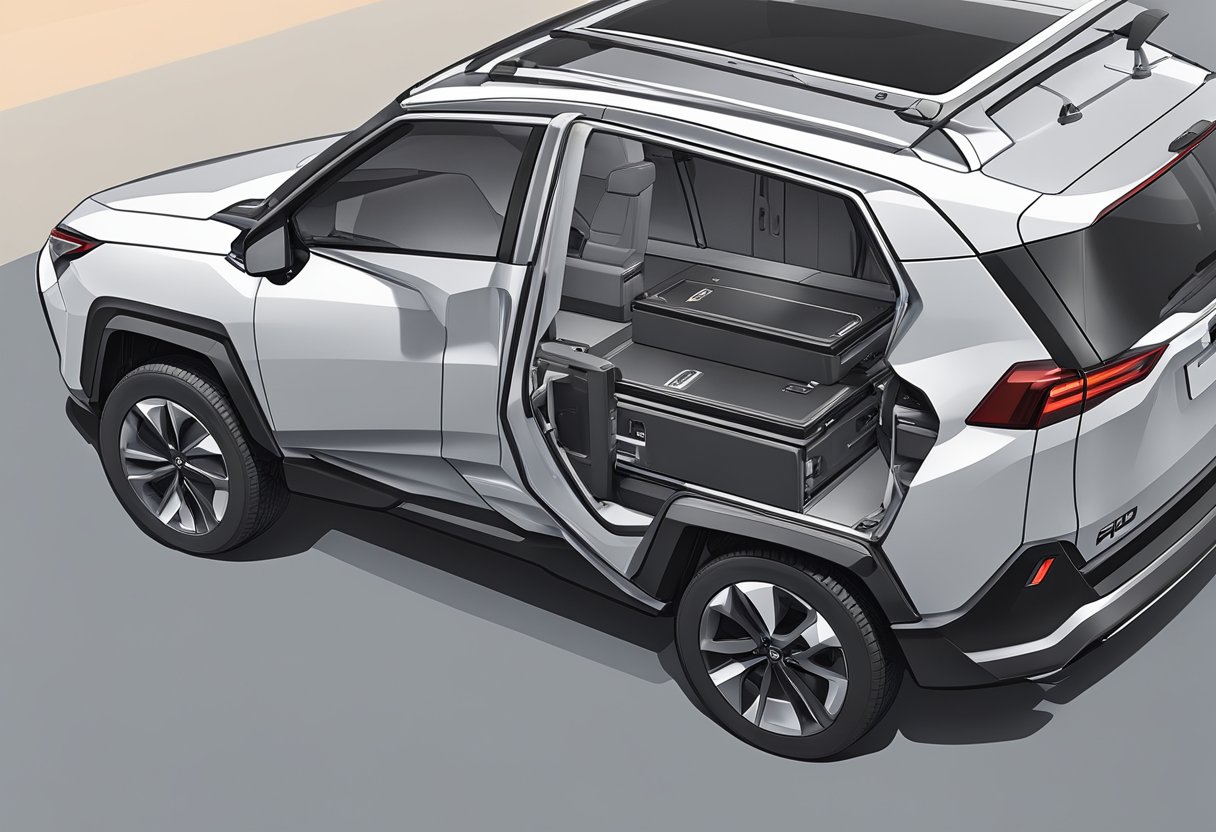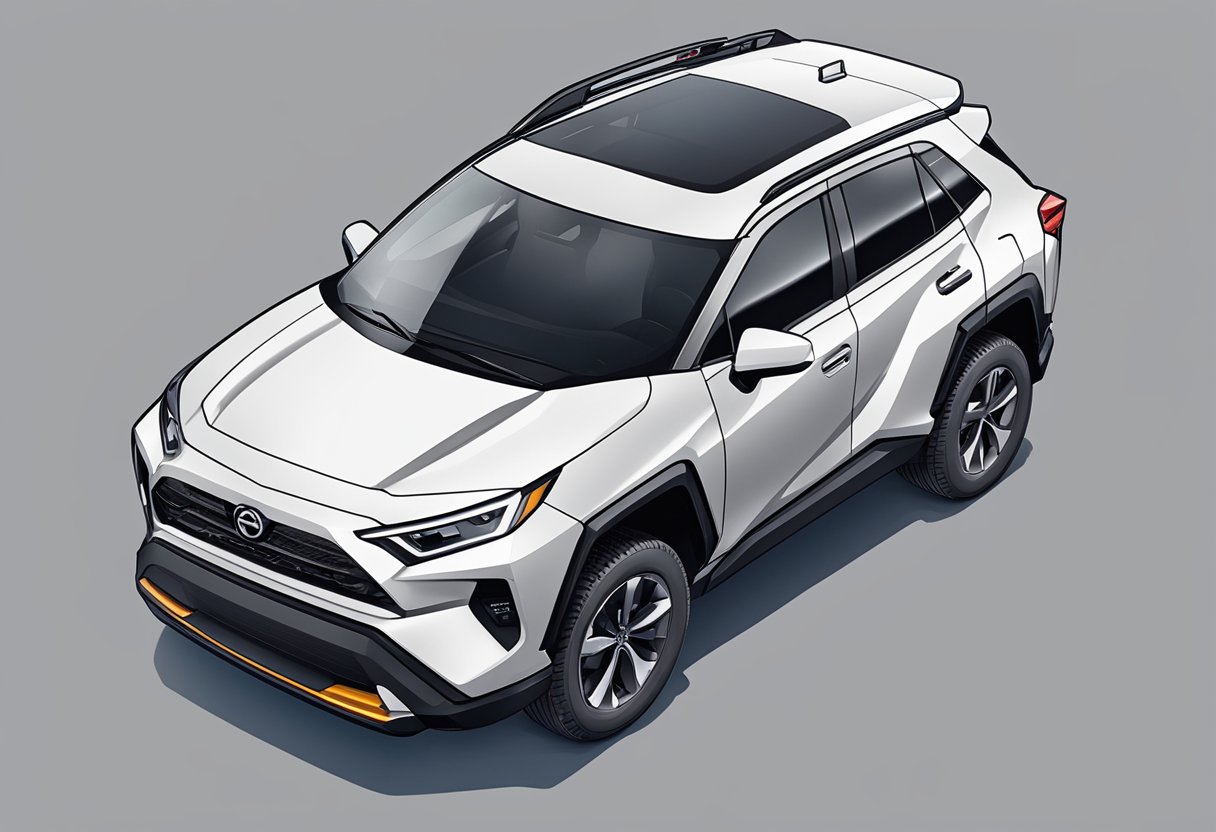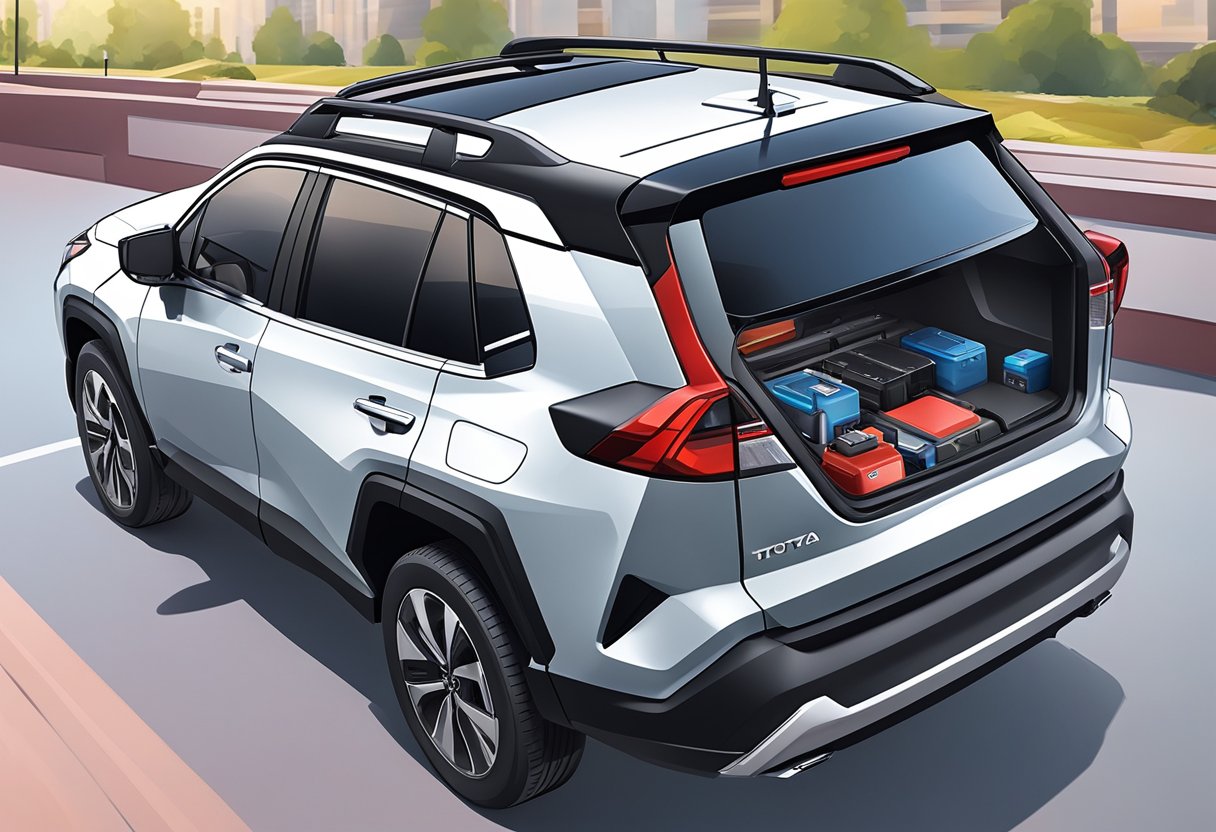*This post may contain affiliate links. As an Amazon Associate we earn from qualifying purchases.
The Toyota RAV4 Prime stands out in the plug-in hybrid market with its impressive battery size. For drivers who prioritize eco-friendly transportation without sacrificing performance, the RAV4 Prime offers a compelling package. Its lithium-ion battery has a capacity that’s nearly on par with some of the early dedicated electric vehicles, equipped with an 18.1 kWh battery. This sizeable battery allows for an all-electric driving range that can reach up to 42 miles on a single charge, which is plenty for daily commuting needs.

The RAV4 Prime’s battery doesn’t just contribute to its electric range; it also enhances the vehicle’s overall efficiency. By seamlessly blending the power sourced from both gasoline and electricity, the RAV4 Prime can optimize fuel economy while offering the flexibility of gasoline backup for longer journeys. The added plug-in capability boosts not just the vehicle’s green credentials, but also its overall power and efficiency, making the RAV4 Prime a standout model in Toyota’s lineup.
Key Takeaways
- The Toyota RAV4 Prime is equipped with an 18.1 kWh lithium-ion battery.
- It has an electric driving range of up to 42 miles on a full charge.
- The plug-in hybrid system provides enhanced fuel efficiency and performance.
Overview of the Toyota RAV4 Prime

The Toyota RAV4 Prime stands out in the SUV market with its robust plug-in hybrid system, mixing efficiency with impressive power. Showcasing a seamless blend of functionality and performance, this SUV makes no compromises.
Design and Features
- Electric Motor Integration: The RAV4 Prime incorporates a sophisticated electric motor system, enabling it to operate silently on EV mode.
- Plug-In Hybrid Advancements: As a plug-in hybrid, the RAV4 Prime offers not just an internal combustion engine but also the benefits of electrical propulsion.
The RAV4 Prime, representing Toyota’s commitment to innovation, features a design that’s as intelligent as it is stylish. Its interior is loaded with forward-thinking technology and comfort-focused amenities aimed to enhance every drive. Exterior-wise, it boasts a sleek profile, which not only contributes to aesthetic appeal but also aids aerodynamic efficiency.
Performance and Engines
- Horsepower: The combined system output reaches a formidable 302 hp.
- Acceleration: High performance is a given, with the SUV achieving 0 to 60 mph in just about 5.7 seconds.
- All-Wheel Drive (AWD): Stability and traction are boosted through the AWD system, engaging both front and rear motors as needed.
The RAV4 Prime’s power is derived from a plug-in hybrid system featuring a gas-powered, front-engine paired with electric motors, effectively delivering a total output that makes it the quickest RAV4 yet. It’s not merely the fastest in its family but also boasts an all-wheel drive setup that ensures competent handling across varying conditions. This SUV presents a harmonious balance between the robust, gas-powered engine and the smooth, immediate torque of the rear motor, which defines its electrifying character.
Understanding Electric Vehicles

Navigating the world of electric vehicles (EVs) and plug-in hybrids can often be like learning a new language. But don’t worry; it’s easier than it sounds. Here, electric motors and hybrids reveal their secrets, shedding light on how they transform energy into motion while aiming for efficiency.
Difference Between EV and Plug-in Hybrid
Electric Vehicles (EVs) and Plug-in Hybrids (PHEVs) may seem similar at first glance—they both plug in and charge up—but they have distinct differences when it comes to their powertrains.
EVs:
- Powered solely by electric motors.
- Store energy in a large battery pack.
- Offer a pure electric range; no internal combustion engines here.
- Measure efficiency in miles per gallon of gasoline-equivalent (MPGe).
Plug-in Hybrids:
- Combine an electric motor with an internal combustion engine.
- Can run on electric power until the battery is depleted, then switch over.
- Fuel efficiency expressed in MPGe when running on electricity, and MPG when using gas.
How an Electric Motor Works
Now let’s get under the hood—or should we say, ‘under the floor’? That’s where you’ll typically find the batteries.
- Electric Motors convert electrical energy from the battery into mechanical energy.
- Unlike internal combustion engines, electric motors have fewer moving parts, often resulting in less maintenance and more instantaneous power.
- The beauty of electric vehicles lies in the instant torque provided by the electric motor, making them quick off the mark.
Remember, whether it’s an EV or a PHEV, the aim is to keep wheels turning while burning less (or no) fuel. Isn’t it amazing what can happen with just a bit of current and a whole lot of ingenuity?
RAV4 Prime Battery Specifications

The Toyota RAV4 Prime’s battery is a significant feature, offering a blend of remarkable electric range and impressive fuel economy. It uses a sophisticated lithium-ion battery pack engineered to power both its electric motors and to provide energy recuperation while braking.
Battery Capacity
- Battery Type: Lithium-ion
- Total Capacity: 18.1 kWh
The battery capacity of the RAV4 Prime is substantial for a plug-in hybrid vehicle. The 18.1 kWh lithium-ion battery pack lies beneath the floor, optimizing the vehicle’s center of gravity and providing ample electric range.
Charging Options
- Standard Level 1 Charging: Approximately 12 hours for a full charge using a 120V household outlet
- Level 2 Charger: Around 2.5 hours for a full charge at a public charging station or with a 240V home charger
For charging, RAV4 Prime owners have multiple options. The vehicle is equipped with a charging cable for Level 1 charging using a standard household outlet. For faster charging, a Level 2 charger can replenish the battery in a fraction of the time.
Battery Lifecycle
- Battery Longevity: Designed to last the lifetime of the vehicle
- Warranty Coverage: Addresses potential concerns about replacement costs
Owners can expect the RAV4 Prime battery to be durable and reliable throughout the vehicle’s lifecycle. The warranty coverage for the battery also adds peace of mind against premature replacement costs.
Driving Experience

The Toyota RAV4 Prime’s driving experience impresses with surprising acceleration and a refined handling package that complements its eco-conscious design. This plug-in hybrid SUV balances power delivery with efficiency, offering a dynamic drive.
Acceleration and Torque
- Acceleration: The RAV4 Prime achieves 0-60 mph in a brisk 5.7 seconds.
- Torque: Its powertrain delivers immediate torque, ensuring responsive acceleration.
This performance stems from the RAV4 Prime’s combination of an electric motor and a gasoline engine. The instant torque common to electric motors contributes to a lively takeoff, while its power delivery remains smooth across the speed spectrum.
Handling and Suspension
- Handling: Drivers experience confident cornering and stability.
- Suspension: The tuning strikes a balance between comfort and sportiness.
Despite the additional weight from an 18.1 kWh battery, the Prime maintains balanced handling. Its suspension absorbs road imperfections, yet retains enough firmness for spirited driving. The vehicle manages to deliver a drive that feels planted, particularly during figure-eight maneuvers which test both power and poise.
Efficiency and Economy
https://www.youtube.com/watch?v=Jb7lwUiDw3o&embed=true
In the world of hybrid and electric vehicles, the Toyota RAV4 Prime stands out with impressive numbers. It’s not just about being environment-friendly; it’s also about the practicality and savings on fuel costs.
Fuel Economy
- MPGe: The RAV4 Prime boasts an estimated 94 MPGe, setting a high bar in fuel economy.
- Combined MPG: On gasoline alone, it achieves an impressive 38 mpg combined.
- Electric Range: Drivers can enjoy up to 42 miles of pure electric driving range.
- Total Driving Range: Combining electric and gasoline power, the RAV4 Prime can cover considerable distances without needing to refuel or recharge.
Charging Costs and Savings
- Industry Standard: The RAV4 Prime is aligned with industry standards for efficiency, offering significant fuel savings over conventional vehicles.
- MPG-e: With figures like 105/84/94 mpg-e (city/highway/combined), it’s evident that the vehicle is designed to optimize fuel use in all driving conditions.
- Charging Efficiency: While home charging times may vary, the standard 120V Level 1 charging cable allows owners to conveniently top up their battery, integrating energy costs into their household budget effectively.
Interior and Comfort

The Toyota RAV4 Prime provides a harmonious blend of practicality and tech-savviness. It ensures that driver and passengers can relish their time on the road with cozy accommodations and up-to-date technological features.
Seating and Cargo Space
- Seats: The RAV4 Prime’s cabin offers comfortable seating with ample room for all passengers.
- Cargo Space: Behind the second row, you have 33.5 cubic feet of space, which expands to a generous 69.8 cubic feet when the rear seats are folded.
The RAV4 Prime’s interior boasts versatility – perfect for both errands and escapades. Rear seats fold nearly flat, making it easier to transport larger items. Expect an average cargo space for a hybrid SUV, which becomes substantial with the seats down.
Technology and Connectivity
- Touchscreen: Centrally located for accessibility.
- Android Auto: Seamless smartphone integration for Android users.
- Head-Up Display: Keeps essential driving info in the line of sight.
Technology within the RAV4 Prime caters to the connected world. With an intuitive touchscreen, navigation becomes less of a hassle, and the integration for Android Auto adds convenience. For those who like to keep their eyes on the road, the available head-up display projects crucial driving information onto the windshield.
Toyota RAV4 Prime Cost Analysis
https://www.youtube.com/watch?v=J8Jsp7kwOSM&embed=true
When considering the RAV4 Prime, potential buyers often focus on the base price and associated trim levels, as well as the long-term ownership costs, which include the battery replacement.
Base Price and Trim Levels
- Base Price: The RAV4 Prime starts at an intriguing point considering its plug-in hybrid technology.
- XSE Trim: The more upscale XSE trim’s starting price includes premium features and amenities.
- Federal Tax Credit: Eligibility can reduce the initial financial outlay significantly.
The base version of the Toyota RAV4 Prime sets the entry cost for those looking to purchase this advanced plug-in hybrid (PHEV). Moving up, the RAV4 Prime XSE trim adds more comfort and tech upgrades, warranting its higher base price. Buyers may also be able to offset the cost with a federal tax credit, subject to eligibility.
Ownership Costs including Battery Replacement
- Battery Replacement: An important consideration affecting long-term expenses.
- Warranty: Offers some peace of mind regarding potential costly repairs.
- Premium Package: May influence resale value and thus the overall cost of ownership.
Long-term expenses for the RAV4 Prime include routine maintenance, with special attention to the cost of battery replacement after the warranty period ends. The warranty offered by Toyota can ease concerns about early battery issues. Additionally, opting for a premium package at purchase might affect the vehicle’s depreciation and impact the resale value.
Safety and Reliability

The Toyota RAV4 Prime is engineered with a focus on both safety and reliability. Its advanced safety features provide peace of mind, while its reputation for dependability ensures drivers can trust their vehicle over the long haul.
Advanced Safety Features
The RAV4 Prime comes with an array of safety features designed to protect its passengers. These include:
- Pre-Collision System with Pedestrian Detection: This system helps to reduce the risk of colliding with a pedestrian or another vehicle by providing audible and visual alerts, and if necessary, by applying the brakes automatically.
- Full-Speed Range Dynamic Radar Cruise Control: It maintains a preset distance from the vehicle ahead and can work at full speed, ensuring comfort and safety during highway driving.
- High-quality headlights for better visibility at night, complemented by automatic high beams that adjust to oncoming traffic.
Safety doesn’t take a back seat in the RAV4 Prime, giving drivers and passengers added confidence on the road.
Toyota RAV4 Prime’s Reputation for Dependability
The RAV4 Prime is known for its dependability, a hallmark of the Toyota brand. Its reliability is built on:
- A rigorously tested plug-in hybrid powertrain that provides an alternative to traditional fuel, without sacrificing performance.
- A solid track record in dependability, with many drivers reporting a trouble-free driving experience over substantial mileages.
Reliability isn’t just about enduring; it’s about providing consistent performance and safety day after day. The RAV4 Prime embodies this principle through and through.
Environmental Impact

The Toyota RAV4 Prime, as a plug-in hybrid SUV, strikes an innovative balance between reducing emissions and maintaining practicality for drivers who are conscious about their environmental footprint.
Electric Range and Emissions
The electric range of the RAV4 Prime is a significant factor in its environmental performance. It offers an impressive emission-free driving capability, which reduces the overall CO2 emissions during its operation on battery power alone.
- Electric Range: The RAV4 Prime can cover a substantial distance powered purely by its electric battery, fostering fewer greenhouse gas emissions.
- CO2 Emissions: By driving on electric mode, the SUV minimizes the release of carbon dioxide compared to traditional combustion engines.
Comparing Hybrids and EVs Impact
When assessing the impact of hybrids like the RAV4 Prime against full EVs, the comparison hinges on fuel economy and how often the vehicles are charged.
- Hybrids’ Fuel Economy: Plug-in hybrids can deliver superior fuel economy figures due to their ability to run on electric power, which for the RAV4 Prime means fewer trips to the gas station.
- Role of Charging: Regularly charging a plug-in hybrid ensures maximization of the electric range, thus reducing reliance on gasoline and cutting emissions significantly.
In the broader context, hybrids serve as a transitional technology, offering environmental benefits akin to EVs while providing the flexibility similar to conventional vehicles. Vehicles like the Prius have paved the way, but the RAV4 Prime evolves this by offering a more substantial electric range, which improves the climate impact profile of plug-in hybrid SUVs.
Rav4 Prime Versus the Competition

In comparing the Toyota RAV4 Prime to its rivals, it’s crucial to consider factors like battery capacity, overall efficiency, and how it stands out in a crowded field of hybrids and plug-in hybrids (PHEVs).
Comparison with Other Plug-in Hybrids
- The RAV4 Prime features an impressive battery, which, despite its sizable frame, nearly matches the Chevrolet Volt in capacity.
- In terms of battery warranty, Toyota offers a 10-year/150,000-mile coverage.
Key Points:
- Battery Capacity: The RAV4 Prime holds it own with a robust battery capacity among PHEVs.
- Warranty: Toyota ensures a long-term commitment to battery life with an impressive warranty.
RAV4 Prime and the Industry
- The RAV4 Prime is a standout in the SUV category, offering a mix of reliability, space, and safety in addition to its electrified powertrain.
- It sustains Toyota’s tradition of hybrid innovation, following in the footsteps of the widely recognized Prius, yet it finds its niche offering superior MPGe compared to the regular RAV4 Hybrid.
Key Points:
- Industry Innovation: The RAV4 Prime contributes to Toyota’s legacy in the hybrid market, drawing from the success of models like the Prius.
- Fuel Efficiency: It boasts high MPGe ratings, reinforcing the company’s commitment to efficient and capable SUVs.
Frequently Asked Questions

In the world of RAV4 Primes, owners and enthusiasts often share a range of questions about their vehicles—from battery specifics to potential issues. This section aims to address some of the most common curiosities.
What’s the kWh capacity of the RAV4 Prime’s battery pack?
Toyota equipped the RAV4 Prime with a 18.1 kWh lithium-ion battery. This substantial capacity allows for up to 42 miles of electric driving range before needing to switch to gasoline or recharge.
How much does it cost to replace the battery in a RAV4 Prime?
The cost to replace the RAV4 Prime’s battery can vary widely. It is an advanced lithium-ion unit and replacing it could be a significant expense, potentially running into thousands of dollars, depending on warranty coverage and labor costs.
Can you give me the lowdown on charging a RAV4 Prime with a 240V cable?
Using a 240V charging cable greatly speeds up the charging process for the RAV4 Prime. With this faster option, the vehicle can typically be fully charged in just a few hours, making it convenient for overnight charging or quick top-ups.
Any tips for charging my RAV4 Hybrid at home with a 120V outlet?
When charging a RAV4 Hybrid with a standard 120V outlet, patience is key. This method is slower and may take overnight to achieve a full charge. It’s perfect for those who can plug in their vehicle in the evening and leave it to charge while they sleep.
I’m curious, how much does a RAV4 Prime weigh?
The RAV4 Prime has a curb weight that reflects its dual powertrain and battery components. While the exact figure can vary based on the trim and added features, it is generally heavier than its non-electrified counterparts.
Are there any common battery issues that RAV4 Prime owners face?
Overall, the RAV4 Prime is seen as reliable, but as with any vehicle, some owners may encounter battery-related issues. These can range from diminished battery capacity over time to the need for battery management system recalibrations. Regular maintenance and software updates can help minimize such problems.
